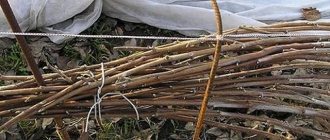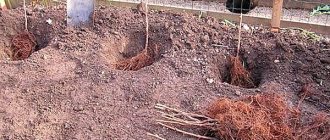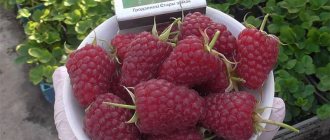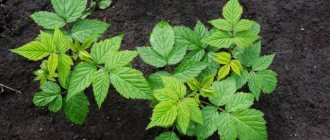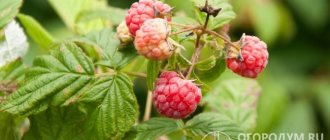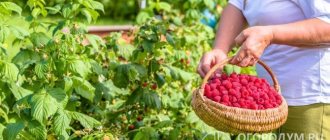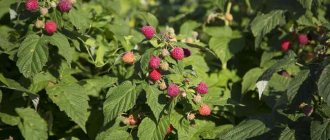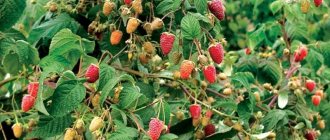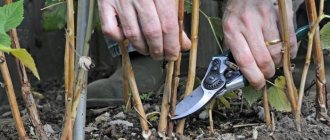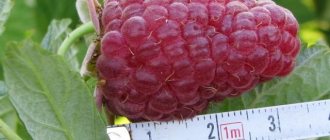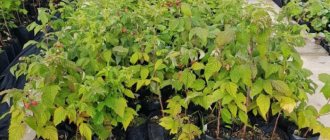Raspberry Elegant attracts the attention of lovers of sweet berries due to its unpretentiousness and productivity. The variety was created by a group of Russian breeders led by Academician I.V. Kazakov. Two main advantages are high yields and early ripening of fruits. In addition, the culture is hardy and undemanding to care.
Photo and description of Elegant raspberry
This raspberry variety is not much different from others. Therefore, its description is relatively general:
- the height of spreading bushes is up to 2 meters;
- the stems are brown and have a small number of thorns;
- annual shoots are colored green and do not require garter;
- leaves are slightly curled, wrinkled, green;
- one bush consists of 7 or less shoots;
- yield up to 3 kg per bush;
- the fruits are crimson in color and have dense pulp;
- The berries can be easily separated from the stalk.
Important. A distinctive feature of this variety is the presence of slight sourness in the berries. Thus, they contain large amounts of vitamin C.
Description of the variety
Remontant raspberry “Elegant” forms powerful and spreading bushes. Shoot formation is average. Biennial shoots are light brown, erect, with a medium spiny type. The main number of thorns is concentrated in the lower part of the shoots and decreases towards the apical part.
Annual shoots are green, with anthocyanin coloring and weak pubescence. The leaves are green, wrinkled, slightly curled. The berry is relatively large, with an average weight of 3.6-3.8 g, red in color, with slight pubescence. The stalks are long. The pulp is tender, sweetish-sour, without a pronounced aroma.
Chemical composition of berry pulp:
- dry matter - a little more than 1 3%;
- sugars - a little more than 5%;
- acids - about 1.2%.
The overall average yield is about 140-142 c/ha. The variety belongs to the category of self-fertile. It is characterized by resistance to major diseases and the most common pests of berry crops.
Characteristics of the remontant variety
It is necessary to understand the main characteristics of this raspberry variety:
- the ability to bear fruit twice per season;
- high levels of frost resistance;
- the culture is unpretentious and has good immunity;
- high yield;
- the berries do not fall off after ripening;
- fruits are not prone to rotting;
- the dense pulp of the berries makes them easy to pick and transport;
- The entire harvest can be harvested before the first frost.
Reference. This raspberry variety cannot be found in the natural environment, since it is bred artificially. This means that this crop is quite demanding on soil moisture.
Diseases and pests, methods of control and prevention
The Elegant raspberry variety has strong immunity to many diseases and is rarely attacked by insect pests. If the rules of care are not followed, raspberries can develop the following ailments:
- Purple spot is a fungal disease that appears on leaves and stems as oval purple spots.
- Powdery mildew - appears with high air humidity, as well as with thickened planting. The first signs of the disease: the appearance of a white coating on the leaf blade and at the ends of young shoots.
- Anthracnose is a fungal disease that affects the leaf blade, stems and fruits, forming dark gray dotted spots with a purple border on them.
To prevent the occurrence of fungal diseases, you must:
- remove weeds in a timely manner;
- carry out prevention;
- remove old shoots;
- carry out autumn digging of the soil around the bush.
Landing
Today, botanists and gardeners cannot agree on the best time to plant raspberries. Some believe that this should be done in the fall, when the plant has already begun to rest. And that means it will survive the winter easier. On the other hand, spring planting will allow you to get the first fruits much earlier. And the root system will be better prepared for the cold.
In any case, it is necessary to land in the following way:
- Holes are dug (50 cm deep and wide), the distance between which is at least 80 cm. You can also dig trenches. The distance between them should be at least 1 meter to make it convenient to pick berries.
- Seedlings are placed in them and then buried with earth.
- The earth needs to be lightly compacted.
- The raspberries are being watered. It should be moderate, 10 liters of water is enough for one bush.
Important. Some gardeners prefer to plant raspberries in mud porridge. That is, they first pour water into the trench, and then plant the bush. This method has a right to exist. It allows the roots to better anchor themselves in the soil.
It is recommended to disinfect the soil using fungicides before planting. You should not plant berries where tomatoes used to be, as the soil will be depleted.
Raspberries, regardless of variety, are afraid of strong winds. Therefore, it is recommended to plant it along the fence. It is also necessary to provide a garter for shoots.
Remontant raspberry Elegant
AGRICULTURAL TECHNIQUES OF REPAIR RASPBERRY
We remind gardeners that, unlike common raspberries, remontant raspberries bear fruit on the shoots of the current year.
Hence the differences in its agricultural technology.
Features of the species.
Remontant raspberry is a plant that, due to its biological characteristics, can produce two harvests a year - in summer and autumn. In the southern regions, the first harvest is obtained from last year's shoots in June. The second - on the shoots of the current year, manages to ripen before the onset of frost, and the bush bears fruit abundantly.
In central Russia, due to early frosts, the berries do not have time to ripen in the fall, because the bush devotes a lot of effort to obtaining a summer harvest. Because of this, the ripening of autumn fruit is delayed by almost a month. Therefore, in most of the country, remontant raspberries are grown as an annual plant. In this case, it bears fruit more abundantly, and the berries have time to ripen before frost.
Choosing a location.
For remontant raspberries, you need to choose the sunniest place on the site. She must literally bathe in the warm rays of the sun all day long. After all, the faster the shoots grow, the sooner the harvest will ripen. Remontant raspberries do not tolerate drafts or cold winds. The best place for it would be the south side of the house, illuminated by the sun all day and protected on all sides from the south winds. A warmer microclimate is formed here. The snow melts faster and young shoots begin to grow. This means that the harvest will ripen earlier.
Remontant raspberry loves fertile soils, rich in organic matter, well permeable. It tolerates increased soil acidity worse than ordinary raspberries. But deoxidation must be carried out very carefully, since the root system of this species is more delicate. It is better to deoxidize the area for remontant raspberries with dolomite flour (2 kg per 6 sq.m.) in the fall, and postpone planting until spring.
Preparing for landing.
For remontant raspberries, predecessors are of great importance. It will not grow well after nightshade crops: tomatoes, potatoes, peppers, eggplants. You cannot plant it in areas where black currants previously grew. Grows well after bulbs and garden strawberries.
Experts recommend planting green manure in this area in the previous year: white mustard, rapeseed, clover, winter rye.
Seedlings with a closed root system can be planted in spring, summer and autumn, but with an open root system - only in early spring or late autumn.
Landing.
Remontant raspberries are planted in clumps of 3-5 bushes or in rows. The distance between the bushes in both the first and second cases is 70 cm.
Leave 2-2.5 m between the rows. First, dig up the area for planting to the depth of a spade bayonet. All weeds are selected very carefully and for digging they add (per 1 sq.m. area): 2 buckets of rotted manure, 3 matchboxes of potassium sulfate, 3 boxes of superphosphate and 1/3 of a bucket of wood ash. Mix all this well and then dig planting holes with a diameter of 35 and a depth of 30 cm. After planting, the root collar of each plant should be at ground level. When it is buried, root shoots appear much more slowly, and the process of formation of young shoots is inhibited. When the root collar bulges, the roots will die in summer and freeze out in winter.
After planting, the plants are well watered (at least two watering cans per seedling) and mulched with peat or sawdust with a layer of 6-8 cm to prevent the growth of weeds and retain moisture in the soil.
In the first year after planting, many seeds of wild plants are stored on the site, which will interfere with the growth of raspberries. They need to be weeded periodically. With proper care, over several seasons the raspberries will grow and fill the entire space between the rows. Then maintenance will become much easier, since she herself will not allow the development of weeds.
Fertilizers.
Remontant raspberries need regular feeding, as they require a lot of nutrients during the period of growth and fruiting. At the beginning of summer, organic fertilizers are applied. Infusions of mullein (in a ratio of 1:10) or bird droppings (1:20) fermented over 3-4 days are best suited. They are diluted with water in a concentration of 1:3 and after abundant watering with clean water, 5 liters per 1 square meter are added. m raspberry. You need to feed remontant raspberries with organic fertilizer 2-3 times per season.
Formation.
During the summer, you need to control the number of emerging shoots, leaving 1 square meter. m 5-6 are the strongest. If you do not remove excess growth, the raspberry tree will become very overgrown. The bushes will not have enough nutrients and sunlight, resulting in small berries and a poor harvest.
Cut out the green shoots with sharp pruning shears as close to the surface of the ground as possible and immediately treat the cuts with a solution of potassium permanganate and cover them with garden varnish.
Remontant raspberry stems can reach 2.5 m in length. To prevent them from bending under the weight of berries and breaking, they must be tied up in a timely manner. When planting in trenches, double-sided trellises are used for this purpose. When planting bushes, stakes are driven into the ground to support the trunks in an upright position.
Watering.
Since remontant raspberries actively bear fruit, they urgently need periodic watering. The soil under the bushes should always remain moist. Usually raspberries are watered once a week, but in hot summers this should be done more often. Unlike other plants, which require moisture only for a short time during fruit formation, raspberries need it constantly.
Diseases and pests.
Remontant raspberries get sick much less often than ordinary ones. And pests don’t visit it that often. However, for prevention against fungal diseases (and they are the same in remontant raspberries as in ordinary ones), it is recommended that in the spring, after the young shoots have grown, they are treated with a 3% solution of Bordeaux mixture. For pests - two weeks after this treatment, spray with the biological preparation "Fitoverm" (in accordance with the dosage indicated on the package).
Preparing for winter.
After the onset of persistent cold weather and the end of fruiting, the entire above-ground part of the remontant raspberry is cut off. They rake up fallen leaves and berries and burn them. After this, the soil is well loosened and mulched. There is no need to rush with pruning. It can be carried out at the end of November even after snow has fallen. The fact is that until this time, nutrients will flow from the shoots and leaves to the root system, which will help the plants to overwinter better and gain strength for the rapid regrowth of young shoots in the spring.
Features of autumn planting of fruit tree seedlings
If you received your seedlings in late autumn or even after snow has fallen, we recommend that you do not rush to plant them in a permanent place, but save them until spring using the following methods:
A. Dig into the soil.
The place for digging the seedlings is chosen as high as possible, where stagnation of water is least possible. Dig a ditch 50 cm deep in the direction from west to east. The southern side is made sloping, the northern side is made vertical.
The seedlings are laid out in the groove one at a time (in no case in a bunch), in an inclined position (at an angle of 45 degrees), with their apex facing south. The roots and half of the trunk are covered with loose soil and watered well so that the moistened soil penetrates into all the voids between the roots; After this, the soil is added again.
To prevent the roots of buried plants from freezing, their location is covered with peat, humus or fertile soil. To protect against mice, spruce or juniper branches are placed between the seedlings and on top.
B. Storage in a snow pile.
To do this, the seedlings are placed in a bunch so that the root collars are at the same level. They are tied from top to bottom, carefully pressing the branches. The roots are covered on all sides with a damp substrate - peat, sawdust, or even better, moss - and wrapped in burlap. Then the entire bunch is wrapped in film, tied and buried deep in the snow, finding a place protected from the sun. To prevent the snow cover from melting longer, sawdust or peat is poured on top.
We advise you to pay close attention to the winterization of the label with the name of the variety. Before digging, they are wrapped in foil or plastic film and tied to the seedlings with twine that does not rot in the soil.
Watering
Elegant raspberries need to be watered when the soil dries out. In this case, it is worth focusing on the weather. If there is a chance of rain, you can skip watering. The fact is that this crop tolerates short-term drought well, but the roots begin to rot when there is excess moisture. Therefore, gardeners do not recommend planting raspberries where groundwater is less than 1 meter deep.
Here are the basic rules for watering:
- About 10 liters of water are used per bush.
- If planting in a trench, it is recommended to use 40 liters of water per square meter.
- Before watering, make sure that the soil is dry to a depth of 5 cm.
If there is too much moisture, the roots begin to rot. As a result, the shoots die. However, if there is a lack of moisture, the berries will be small and sour. Therefore, the gardener must look for himself when it is necessary to water.
Reproduction
Remontant raspberries are propagated in two ways - root suckers or root cuttings.
Reproduction by root suckers
They use offspring that appeared by the end of spring or grew by autumn. Judging by numerous reviews from gardeners, autumn shoots have the best survival rate.
You need to choose strong shoots with a good root system for propagation. It is necessary to trim the top of the shoot; for the remaining stem, the optimal height should be no more than 40 cm.
Propagation by root cuttings
In the autumn, large roots of the bush (at least 1 cm in diameter) are dug up to cut them into cuttings 10-15 cm in length.
The cuttings are planted horizontally in the places where they will grow, or in separate containers, which are best placed in a greenhouse to speed up growth.
The cuttings need to be deepened by about 8 cm and watered immediately. When planting root cuttings is postponed until spring, the best storage method is in a cool place, in damp sawdust.
I chose raspberries based on reviews, so I consider it my duty to also leave a review that will help other gardeners make their choice. Elegant - remontant raspberries with powerful, tall stems, bearing fruit from July to September. The berries are quite large and can be easily removed from the stalk. at the same time, they do not crumble, even if ripe, and are well transported over long distances. Winters well in the Moscow region (I don’t prune shoots in the fall), is unpretentious and not susceptible to diseases and pests
What is most important for me is that the plant is very easy to care for, I can only get out to the site on weekends, so I can’t master complex agricultural techniques. In general, I don’t do anything special with these raspberries, but I harvest them every year, so these raspberries suit me very much
Of the red-fruited varieties, I chose Elegant. I still have a yellow “Yellow Giant” and a black “Cumberland” growing. In principle, there have never been any problems with raspberries. In the fall I cut it flush to the ground, watered it a couple of times in the heat, and harvested it in the fall. That's all care.
The remontant raspberry variety Elegant is characterized by high yield, excellent taste and good survival rate. Allows you to harvest without haste, in several stages, since ripe berries do not fall off for two weeks.
https://dachaotzyv.ru/malina-elegantnaya/
https://fermilon.ru/sad-i-ogorod/kustarniki/malina-elegantnaya.html
Fertilizer
Elegant raspberries are a variety that bears fruit well. But with a lack of minerals in the soil, the berries become smaller. In this case, the plant can no longer produce as much sugar. As a result, the crop becomes sour. However, the amount of sugar is also affected by lighting, so it is recommended to plant the crop on the sunny side.
It is necessary to fertilize with organic and mineral fertilizers as follows:
- When planting, it is recommended to use organic fertilizers. It is better to dilute them in water so that the roots absorb all the minerals. Excessive amounts of fertilizer will damage the root system because it contains high levels of ammonia.
- In the spring, after the snow melts, it is also necessary to repeat the use of organic fertilizers, especially if the plant was planted in the fall. Provided the bushes are planted in the spring, this will be the first bait.
- Next, you need to add mineral fertilizers. This is done during a period of active growth. It is important that they contain enough phosphorus, potassium and superphosphate. Fertilizers can be bought in specialized stores, and they are used in liquid form according to the instructions.
- Once again, mineral fertilizers are added during flowering.
- The last feeding occurs during the period of fruit set. After this, the plant must be left alone, repeating the application of organic matter only before winter.
Reference. If the soil is enriched with a sufficient amount of minerals, raspberries will actively grow and bear fruit. Their presence is especially important in winter, otherwise the crop may not survive the cold.
Landing Features
In order for raspberries to bear fruit consistently for many years, it is necessary to plant them in a timely and correct manner. Of great importance are:
- planting dates;
- location;
- soil quality;
- buying a seedling.
Recommended timing
Remontant raspberry Elegant can be planted in spring and autumn. Spring planting is suitable for regions with early winters and where the weather is too dry in autumn. The seedling is planted when consistently warm weather sets in, after the end of spring frosts.
Advice! Raspberry planting must be completed before sap flow begins.
Autumn planting is done 25 days before the onset of the first frost. In the middle zone - from early September to early October, in the south - until mid-November. Delay in planting can lead to freezing of the root system and death of the plant.
Remontant raspberry seedlings purchased in a container can be planted in spring, summer and autumn, but this is not recommended during peak heat.
Choosing a suitable location
The Elegant raspberry variety can bear fruit throughout the season, but many gardeners like to grow the crop in a different way, so that the plant bears fruit from the end of summer until the onset of the first frost.
A place for planting raspberries is selected that is well lit and warmed by the sun. This may be an area along a low fence and next to other berry bushes.
Advice! Raspberries are not recommended to be planted next to currants, as they have common diseases and insect pests.
The soil should be light with normal acidity.
Selection and preparation of planting material
It is better to purchase raspberry seedlings of the Elegant variety in a specialized store, nursery or from trusted suppliers. Before purchasing, you need to pay attention to the following indicators:
- Roots and buds. There should be at least 3 buds at the base of a young plant. The root system should be healthy, elastic, dense and moist.
- The escape. The seedling has from 1 to 3 healthy stems.
- Package. If a purchased seedling is wrapped in a plastic bag, then when it stays in it for a long time, the root system quickly becomes waterlogged and dies. After purchasing, it is better to wrap the raspberries in natural fabric.
Landing algorithm
Growing varietal raspberries is not difficult, the main thing is to adhere to planting technology:
- A hole is dug measuring 30x35.
- When mass planting, the interval between bushes should be at least 70 cm.
- At the bottom, make a mound of prepared soil: fertile soil, humus, wood ash and mineral fertilizers.
- The roots of a young plant are straightened and placed on a prepared mound.
- The raspberry seedling is carefully buried, compacting each layer so that the root collar is at ground level.
- After planting, the area is watered. For one bush – 10-20 liters of water.
- To ensure that the young seedling overwinters well, the ground is mulched with straw, leaves or humus.
Trimming
Raspberries need to be pruned every year. This is required to rejuvenate it, remove diseased shoots and increase the yield.
Here's how it all happens:
- Pruning is done in the fall 2 - 3 weeks before the cold weather. First, you need to dig up the raspberries and remove all the young shoots and weeds.
- Then the leaves are removed from the shoots. Their presence can cause the plant to freeze.
- All dry shoots and those that seem diseased are removed at the root.
- Healthy shoots need to be trimmed so that their height is no more than 1 meter. If you leave more, there is a risk of the raspberries freezing in winter.
- Side branches also need to be removed.
Important. All cut branches must be burned. They may contain pests and pathogenic microbes, which will later be transferred to other crops if everything is not set on fire.
Preparing for winter
Elegant raspberries tolerate frost well. However, the gardener still needs to take appropriate measures to preserve the crop.
To do this, do the following:
- Trim according to the instructions above.
- Weed removal and digging. This will help the roots receive the required amount of oxygen and nutrients.
- Bend the raspberries so that the branches are fastened together and cannot bend. How much to bend should be taken into account the level of precipitation in winter. It is required that the raspberries be completely covered with snow.
Reference. If there are not enough minerals in the soil, the plant will begin to get sick, so it will be less likely to survive the cold. It is recommended to apply organic fertilizers before wintering.
Protection from pests and diseases
Elegant raspberries have excellent immunity, so they are rarely exposed to various diseases. However, such a possibility cannot be completely excluded. In addition, the crop is periodically attacked by various pests.
It is worth considering what problems gardeners face:
- Ants. They appear quite often on raspberries. Insects damage the shoots themselves and the root system. You can get rid of them using special poisons that must be used according to the instructions. It is recommended to spray the bushes before flowering begins.
- Aphids also often appear on raspberry bushes. You can fight it with soapy water, but it is more profitable and effective to use industrial poisons.
- Root rot. It appears due to waterlogging of the soil. You can only get rid of it physically. That is, the plant is dug up, the affected area is removed, the soil is disinfected with fungicides, and the bush is planted back.
- Gray rot also appears due to improper watering. It can be seen on the leaves. Fungicide treatment is required, and the affected area is removed.
- Anthracnose, when dark spots appear on the leaves. They curl up and dry out quickly. The cause of the disease is excessive watering or prolonged rains. Diseased branches are removed, and the bush itself is treated with copper sulfate or nitrafen solution.
- White spotting - causes of appearance and methods of control, like anthracnose.
- Ring spot on leaves. Appears due to soil contamination by nematodes. You can get rid of them using fungicides.
In principle, Elegant Raspberry withstands all problems, so there is often no need to use any solutions. However, one must understand that the spread of the disease will lead to a decrease in yield. Therefore, it is recommended to remove the affected shoots immediately.
Recommendations for cultivation
To get a rich harvest when growing raspberries of the “Elegant” variety, you need to provide the berry bushes with the most proper and good care:
- Plants should be watered abundantly, but relatively rarely, proportioning the volume of irrigation to the condition of the soil on the site and the stage of the plant’s growing season;
- from the last ten days of August it is not recommended to water raspberry bushes, since it is during this period that there is a sufficient amount of natural precipitation, and waterlogging prevents the ripening of shoots;
- good results are obtained by using mullein solution with the addition of a small amount of wood ash for feeding raspberry bushes;
- starting from the third year after planting, raspberry bushes should be actively fertilized with both organic and basic mineral fertilizers.
Preparing berry crops for winter should begin in the fall, before the onset of sharply negative temperatures. In the autumn period, not only fertilization is carried out, but also preventive spraying with insectofungicidal preparations, as well as pruning of bushes. If it is necessary to protect plants from freezing in the northern regions, plants are covered for the winter.
Reproduction methods
This crop reproduces quickly using roots. That is, all shoots come from them. Therefore, it is recommended to do the following to obtain young shoots:
- dig up a bush;
- clear it from the earth;
- check for rot or other abnormalities;
- remove the root with a sharp knife;
- treat the cut area with activated carbon.
After this, you can plant both parts of the bush in different places. However, in the first year the yield will be minimal.
